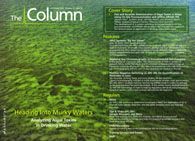Meat Authentication Using HPLC–MS–MS
Researchers from the Institute of Food Chemistry at Westfälische Wilhelms‑Universität Münster in Germany have developed an optimized high performance liquid chromatography coupled with mass spectrometry (HPLC–MS–MS) method using multiple reaction mode (MRM) and MRM3 for detecting horse and pork in highly processed food.
Photo Credit: rubberball/Getty Images

Researchers from the Institute of Food Chemistry at Westfälische Wilhelms‑Universität Münster in Germany have developed an optimized high performance liquid chromatography coupled with mass spectrometry (HPLC–MS–MS) method using multiple reaction mode (MRM) and MRM3 for detecting horse and pork in highly processed food. The paper published in the Journal of Agricultural and Food Chemistry outlines the detection of horse or pork meat in different sample matrices. 1
The issue of food fraud came to the forefront of European news in 2013 when there were widespread reports product mislabelling. In the UK alone there were several cases where products labelled as beef were actually 100% horsemeat. Although eating horsemeat is not necessarily a danger to health, it does cause concern over food supply chain security.
The principle methods used by analysts are enzyme-linked immune sorbent assays (ELISA) and polymerase chain reaction (PCR) methods, but these techniques can lack sensitivity and specificity when applied to processed food samples. Mass spectrometry-based methods have been reported in the field for authentication of meat; the authors of the study report that they have previously published the first MRM-based method for the detection of raw horse and pork in raw beef and chicken by detecting species-specific marker peptides.1
Samples of beef, pork, and horsemeat were bought in Germany and The Netherlands and were processed in‑house to form meat loafs and frikadeller (very similar to a fried hamburger patty). Commercial samples of salamis, sausages, and canned meat were used for comparison. Around 1 g of each sample was extracted using extraction buffer composed of 6 M urea, 1 M thiourea, and 50 mM Tris–HCL and were subsequently analyzed using HPLC–MS–MS in MRM.
The authors were able to detect trace levels of horse and pork meat at levels of 0.24% in beef meat matrix, and established that the marker peptides used were stable enough to resist thermal processing. The paper also states that the method does not require 2D-PAGE or off-gel fractionation and so the method could be applied in routine analysis. — B.D.
Reference
1. C.V. Bargen et al., Journal of Agricultural and Food Chemistry DOI:10.1021/jf503468t (2014).

Accelerating Monoclonal Antibody Quality Control: The Role of LC–MS in Upstream Bioprocessing
This study highlights the promising potential of LC–MS as a powerful tool for mAb quality control within the context of upstream processing.
Using GC-MS to Measure Improvement Efforts to TNT-Contaminated Soil
April 29th 2025Researchers developing a plant microbial consortium that can repair in-situ high concentration TNT (1434 mg/kg) contaminated soil, as well as overcome the limitations of previous studies that only focused on simulated pollution, used untargeted metabolone gas chromatography-mass spectrometry (GC-MS) to measure their success.
Prioritizing Non-Target Screening in LC–HRMS Environmental Sample Analysis
April 28th 2025When analyzing samples using liquid chromatography–high-resolution mass spectrometry, there are various ways the processes can be improved. Researchers created new methods for prioritizing these strategies.
Potential Obstacles in Chromatographic Analyses Distinguishing Marijuana from Hemp
April 28th 2025LCGC International's April series for National Cannabis Awareness Month concludes with a discussion with Walter B. Wilson from the National Institute of Standard and Technology’s (NIST’s) Chemical Sciences Division regarding recent research his team conducted investigating chromatographic interferences that can potentially inflate the levels of Δ9-THC in Cannabis sativa plant samples, and possible solutions to avoid this problem.

.png&w=3840&q=75)

.png&w=3840&q=75)



.png&w=3840&q=75)



.png&w=3840&q=75)











